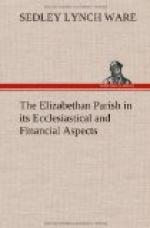Indeed, though parish lands and houses were generally vested as to title in trustees (often a numerous and cumbersome body),[215] the churchwardens themselves and sometimes other accountants,[216] who like the wardens were appointed from year to year, usually exercised the actual management. The feoffees existed chiefly for the purpose of making it difficult to alienate the parish properties, “and the larger the trust body the more difficult such alienation was supposed to be."[217]
Contenting ourselves with the above examples, which could easily be multiplied, we pass on under this same head of general endowments to an interesting form of personal property, viz., cattle, for not only did the wardens derive receipts from parish holdings of real estate, but also from Endowments of Cows or Sheep. The Pittington, Durham, Twelve Men, a sort of parish executive and administrative body, enact in 1584 “that everie iiij pounde rent[218] within this parrishe, as well of hamlets as townshippes, shall gras[219] winter and somer one shepe for the behoufe of this church;"[220] and we are told that these “Church Shepe,” as they were called, were here one of the chief means of raising funds for parochial purposes.[221] It was the custom of pious donors, especially among the lowly, to leave one or more sheep or cows to their parish. In the year 1559 twelve sheep were thus given or bequeathed to Wootton Church, Hants, by ten donors.[222] These sheep, as well as the parish cows, were often hired out to parishioners, who gave security for their return. Sometimes they were given to poor men at a reduced rent, and thus they served to support the poor.[223]




